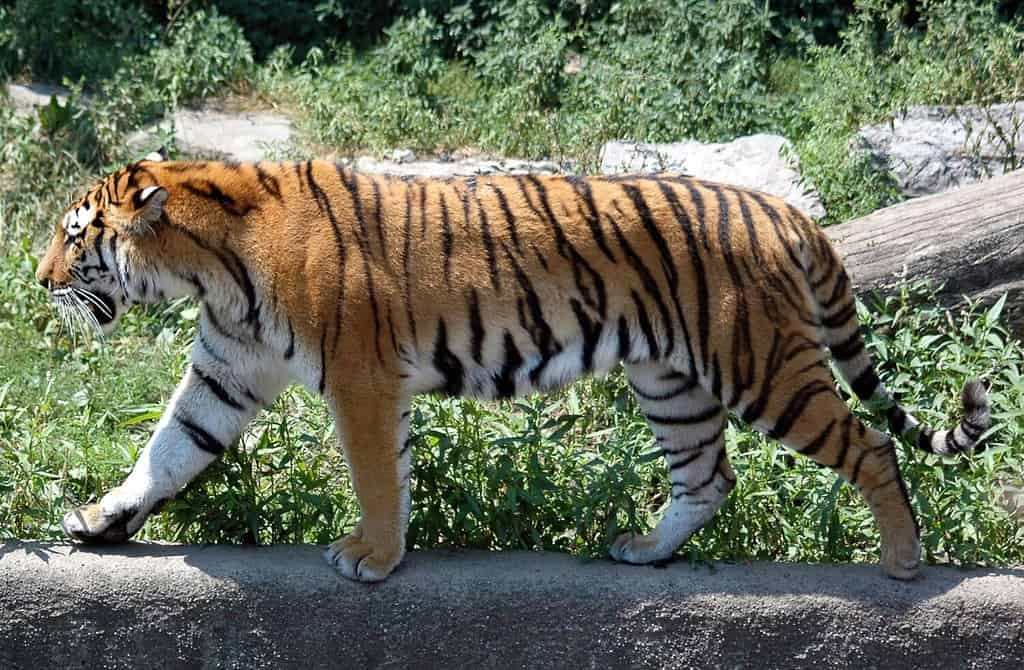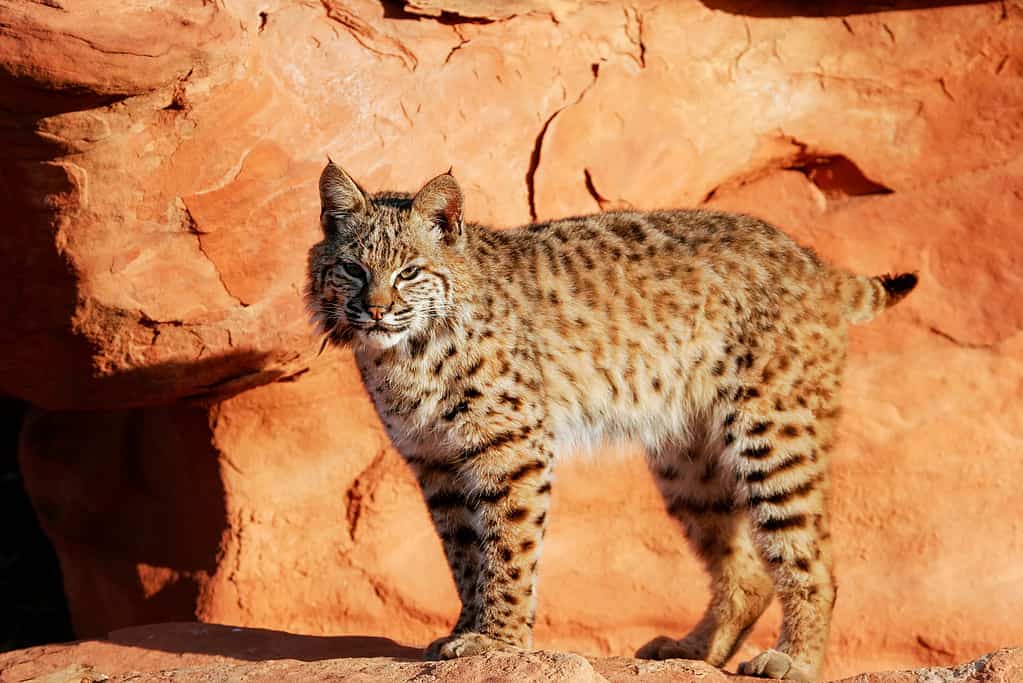If a single bobcat fights a tiger, it’s clear who the winner will be. But what happens when four feisty bobcats enter the scene? Working together, could they stand a chance against the largest cat in the world? It’s time to find out! Follow along as we play out this zany animal matchup to deliver another epic battle. Can 4 bobcats take down a full-grown tiger? Read on to find out.
Bobcats

Male and female bobcats prefer to lead a solitary lifestyle.
©Laurie E Wilson/Shutterstock.com
The chances of four bobcats teaming up to take down any animal are highly unlikely. Bobcats aren’t like lions who live in groups. Instead, these smaller felines prefer to hunt and live alone. Bobcats have their own territories, and they don’t share them with other cats of the same sex. They rely on scent marking to establish and maintain their boundaries, keeping intruders at bay. Female bobcats generally have territories covering 6 square miles. Male bobcats have larger territories, spanning around 25 square miles, which may overlap with the females’ territories. Within their territory, bobcats establish a network of dens to serve various purposes. The natal den, often found in caves or trees, is their main residence.
Full Grown Tiger

Male tigers are highly aggressive toward other male tigers.
©Kathleen Struckle/Shutterstock.com
Would a full-grown tiger pick a fight with a group of bobcats? They would if they were hungry or felt the bobcats were encroaching on their territory. Tigers also like to live alone. They interact briefly for mating purposes and occasionally to share kills. Otherwise, they’re highly territorial. Tiger territories vary in size based on prey density and other factors. Males have larger territories, while female territories are much smaller. It’s typical for a tigress to take over parts of their mother’s territory. Aggression among adult male tigers is often influenced by population density, aka territory disputes. This is because females are a coveted resource for males.
Round 1: Size

On average, bobcats weigh between 8 to 33 pounds.
©Don Mammoser/Shutterstock.com
Bobcats are medium-sized cats that typically weigh between 8 to 33 pounds. They’re smaller than their lynx counterparts with a length ranging from 25 to 42 inches, not including their bobbed tails. In general, male bobcats tend to be larger in size than females. But it doesn’t matter how much larger they are; there isn’t a male bobcat out there who can compete with the size of a tiger.
Tigers are the largest cat species in the world, with Siberian tigers being the biggest of all. A male Siberian can weigh up to 700 pounds and measure up to 12 feet long. The largest bobcat on record had a weight of 52 pounds. Even if there were four of the biggest bobcats in the world, they’d still weigh less than half the weight of a fully-grown Siberian tiger. It would take about 20 fat bobcats to come close to the weight of an adult tiger.
Round 2: Skills

Tigers are comfortable in the water; they can swim fast and far.
©Martin Mecnarowski/Shutterstock.com
Bobcats have incredible climbing skills, allowing them to navigate through rocky terrain and scale tall trees effortlessly. These quiet hunters rely on their agility and patience to stalk their prey unnoticed. Once within striking distance, bobcats use a pouncing technique to capture their prey. In a single leap, they can lift 10 feet off the ground.
Tigers are also highly skilled cats, capable of jumping, swimming, climbing, and stalking. Tigers prefer hunting on land, but they’re not afraid to take to the water to drown resistant prey. And male tigers might swim over 15 miles a day to patrol their territory. On land, tigers can leap up 16 feet and cover over 20 feet in a single bound. Their gymnastic skills are possible because of their strong legs. Their powerful forelimbs are also instrumental in holding tightly onto their prey. As for stealth skills, tigers usually stalk their prey until they’re within 20 to 30 feet. Once within striking distance, they can go for the prey’s neck, severing the spinal cord.
Round 3: Strength

Tiger paws can crush bones and snap necks with a single swipe.
©iStock.com/Cheryl Ramalho
Could a tiger survive four pouncing bobcats? Most likely, and they might even be able to neutralize all of the threats. These big cats have paws that can kill with a single swipe. A powerful blow from a tiger’s paw can kill a full-grown wolf. And if the tiger punch doesn’t kill their opponent, it’ll certainly break some bones.
When bobcats are hunting, they rely on their bite more than their swipe. Adults have about 28 teeth, and they use their sharp canines to target the prey’s skull, neck, or throat. Bobcats have a bite force of 548 Newtons, which is powerful for their size, but it’s nothing in comparison to tigers. The tiger’s bite force far surpasses the bobcats at an impressive 1,050 PSI. The only saving grace for the bobcat here is their numbers. When you consider there are four bobcats launching the attack, there’s almost a chance of the smaller felines gaining an advantage.
Picture it; One bobcat bites the back of the tiger’s neck, the other the top of the skull, the other the front of the throat, and the fourth bobcat goes for the back. The smaller felines could inflict some damage, but they’d still be outmatched and unprepared. Tigers are used to killing large prey on a regular basis, whereas bobcats focus on smaller kills, like rabbits.
Who Wins?
The full-grown tiger wins. The tiger is the biggest cat in the world, and they’re highly skilled hunters. The group of bobcats could leave the tiger with some serious wounds, but it’s not likely they’d be fatal. Instead, odds are the tiger winds up killing all four bobcats and having a feast. A tiger can eat up to 100 pounds of food, which means there will be leftovers. After eating the first bobcat, the tiger will store the other three. Whenever a tiger doesn’t finish their meal in one sitting, they’re smart enough to cover it with soil and leaves, saving the leftover meat for later.
Thank you for reading! Have some feedback for us? Contact the AZ Animals editorial team.








